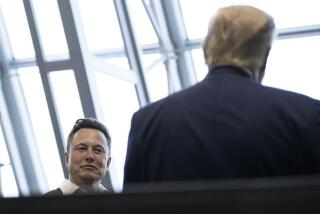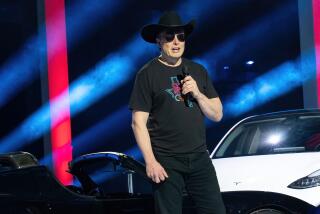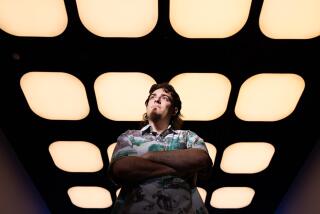Solar venture gains steam
- Share via
DIMONA, ISRAEL — On the scorched floor of Israel’s Negev Desert blooms a field of 1,640 robotic mirrors that behave like sunflowers.
Slightly larger than pingpong tables and guided by a computer, they turn imperceptibly to follow the sun and focus its rays on the pinnacle of a 200-foot tower, where a water boiler will soon start producing high-pressure steam.
This futuristic assembly is Arnold Goldman’s scale model and testing ground for five larger solar fields his company plans to build in the Mojave Desert to supply up to 900 megawatts of clean energy to California in the next decade.
Goldman is a UCLA- and USC-schooled Israeli entrepreneur who built the world’s leading solar thermal power company, Luz International, in the 1980s, then watched it go bankrupt in 1991 as oil prices dropped and California decided not to renew property tax credits for solar producers.
Now he’s a player again, and his comeback illustrates the extent to which solar thermal power is regaining favor with policymakers and investors.
His new company, Oakland-based BrightSource Energy Inc., signed a power-buying agreement with Pacific Gas & Electric in April; it is believed to be the largest in the history of solar power and would produce enough electricity to power 540,000 homes each year.
In May, the company raised $115 million from a high-profile group of investors including Google.org, the philanthropic arm of Google Inc., and BP Alternative Energy.
Like other clean-energy entrepreneurs, Goldman has benefited from rising oil prices and an array of government policies aimed at reducing fossil fuel consumption and staving off global warming.
But the 65-year-old engineer and his Israel-based design team have a unique selling point: a technology radically different from what he developed in the 1980s and other solar power producers imitated.
“This is the highest-performing, lowest-cost solar thermal energy system in the world today,” Goldman told 550 guests, including investors and potential suppliers, at Thursday’s inauguration of his pilot solar field in Dimona, Israel.
The 1980s system used long troughs of curved mirrors, guided by computers, to heat synthetic oil passing through vacuum-sealed tubes to 735 degrees. The oil heated water to produce steam and run an electric turbine. Goldman’s company built nine solar power stations using that system in the Mojave Desert from 1984 to 1990. They still operate, producing 350 megawatts of power.
The new technology will employ several “power towers” at each commercial plant, starting with a 100-megawatt plant the company expects to start building next year on the Ivanpah dry-lake bed. An array of hundreds of mirrors known as heliostats will reflect sunlight onto a boiler atop each tower, and the resulting steam will power a turbine.
BrightSource executives say the power-tower technology is more efficient in several ways: The heliostats are cheaper to build and operate. They heat water directly, with no need for oil. And they achieve a higher concentration of sunlight, higher temperatures (up to 1,000 degrees Fahrenheit) and higher steam pressure.
That should make solar electricity competitive in price with that produced by gas-powered turbines as long as Congress prolongs the tax breaks for solar producers, said John Woolard, president of BrightSource.
The new technology, however, has yet to be tested on a large scale. The pilot field here is expected to start producing steam next month, serving as a proving ground for BrightSource as it tries to lure investors in the California plants.
Justin Adams, venture business unit leader at BP Alternative Energy, says BrightSource faces several hurdles in making its technology work.
“They have to show they can manage steam at such high pressure 60 meters above the ground,” Adams said. “They have to make sure everything is minutely controlled in terms of focusing all those mirrors, and they have to do this over a period of years without major outages.”
Thursday’s ceremony was sweet vindication for Goldman, a slight, bearded man who said he was personally shattered by the failure of his first solar venture. He had started Luz as an Israeli firm after moving to Jerusalem from Los Angeles in 1977 and saw solar power as a way of saving the world.
The bankruptcy of Luz International, the L.A.-based company he set up to build the early California plants, destroyed the Israeli subsidiary. Goldman drifted into other ventures. In an interview this week, he said the 1997 Kyoto Protocol on climate change let him dream again that solar power could produce most of America’s electricity.
The protocol, which requires a drop in greenhouse gas emissions, took effect in 2005. Although the United States has not ratified it, Goldman said the push for clean energy elsewhere, especially in Europe, had an influence in California; the state now requires that publicly owned utilities get 20% of their power from renewable sources by 2013.
Goldman began reassembling his best Israeli engineers in 2004. Like a Hollywood sequel, he named the new venture Luz II and founded BrightSource as its parent company to seek California contracts.
The company secured its first major infusion of venture capital in 2006 from VantagePoint Venture Partners, which remains BrightSource’s largest equity holder.
“The idea of coming back together to finish what we started was electrifying,” Goldman said.
--
More to Read
Inside the business of entertainment
The Wide Shot brings you news, analysis and insights on everything from streaming wars to production — and what it all means for the future.
You may occasionally receive promotional content from the Los Angeles Times.








